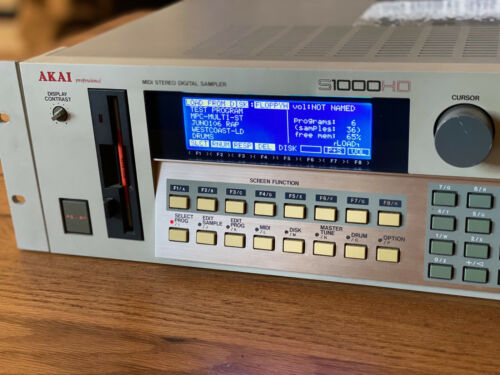The Akai S1000 is a popular digital sampler synthesizer that was first introduced in 1986. It is regarded as one of the most important and innovative electronic instruments of its era.
The Akai S1000 was one of the first digital samplers widely adopted by professional musicians and producers. It was renowned for its excellent audio and capacity to store a sizable amount of sample data. The S1000 included an integrated hard drive that could hold up to 20 seconds of mono audio or 10 seconds of stereo audio. Input and output options for the sampler included MIDI and SCSI, making it easy to integrate into a studio setup.
Another noteworthy feature of the Akai S1000 was its user-friendly interface. Thanks to the front panel’s large LCD screen and an assortment of knobs and buttons, it was simple to manage the several features and settings. A sequencer already included in the sampler allowed users to record and alter their tunes.
The ability to modify samples was one of the Akai S1000’s most distinctive features. Many sample editing options, including the capacity to alter a sample’s pitch, length, and loop points, were included with the S1000. Additionally, it contained an integrated effects processor that users could use to give their samples reverb, delay, and other effects.
Hip-hop, electronic, and pop music, among other musical genres, frequently employed the Akai S1000. Numerous artists utilized it, including Depeche Mode, Nine Inch Nails, and Dr. Dre. The S1000 was a popular choice for soundtracks for movies and TV shows because of its propensity for producing authentic sound effects and orchestral simulations.
The S3000 series eventually took the place of the Akai S1000 and provided even more features and capabilities. The S1000 is still a well-liked and coveted instrument among fans and collectors of electronic music. Given that it is still employed in many contemporary songs today, its legacy endures.
Overall, the music industry was transformed by the high-quality sound, ample storage, and user-friendly design of the Akai S1000 synthesizer. Many musicians and producers considered it a necessary instrument due to its adaptability and capacity for sample manipulation, and its legacy is still felt today.
Used by
- Depeche Mode: The band used the S1000 on their album “Violator”, which was released in 1990.
- Nine Inch Nails: Trent Reznor, the frontman of Nine Inch Nails, has used the S1000 extensively throughout his career. He used it on the band’s debut album “Pretty Hate Machine” (1989) and on their 1992 EP “Broken”.
- Dr. Dre: The hip-hop producer and rapper used the S1000 on many of his early albums, including “The Chronic” (1992) and “Doggystyle” (1993).
- A Tribe Called Quest: The hip-hop group used the S1000 on their album “The Low End Theory” (1991).
- Public Enemy: The hip-hop group used the S1000 on their album “Apocalypse 91…The Enemy Strikes Black” (1991).
- The Prodigy: The electronic group used the S1000 on their album “Experience” (1992).
- The Chemical Brothers: The electronic group used the S1000 on their album “Exit Planet Dust” (1995)
- Goldie: The drum and bass artist used the S1000 on his album “Timeless” (1995)


